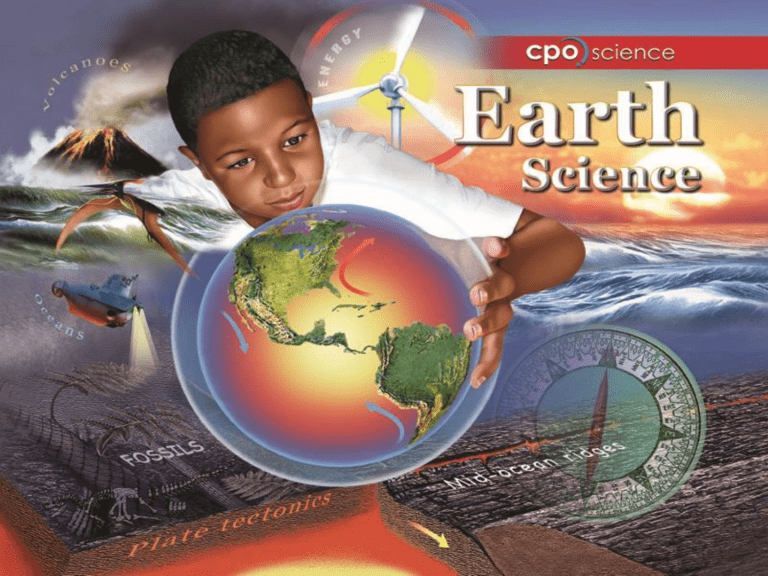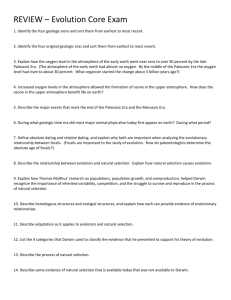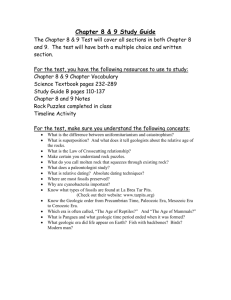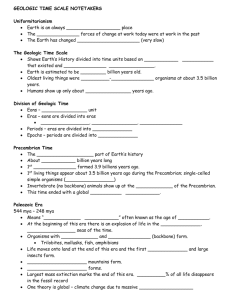Section 9.2 - CPO Science

Introducing Earth
Chapter Nine: Earth and Time
• 9.1 Relative Dating
• 9.2 Geologic Time
Investigation 9A
Time and Tree Rings
• Do tree rings tell a story?
9.2 Geologic Time
• Scientists have developed a model of the history of life on
Earth called the geologic time scale .
• Paleontologists divide the geologic time scale into blocks of time called eras and periods .
9.2 Precambrian era
• The Precambrian era lasted from Earth’s formation 4750 until 542 million years ago (mya).
• The first cells appeared in the Precambrian era.
9.2 Paleozoic era
• The Paleozoic era lasted from 542 to
251 mya.
• Paleozoic is a
Greek word meaning
“ancient life.”
9.2 Paleozoic era
• Rocks from the Paleozoic Era contain fossils of snails, clams, corals, and trilobites.
9.2 Paleozoic era
• Therapsids are a group of animals that dominated the land in the Permian Period of the Paleozoic era.
• Scientists have determined that mammals evolved from therapsids.
9.2 Mesozoic era
• The Mesozoic era lasted from 251 to 65 mya.
• This era is often called the Age of Reptiles.
9.2 Cenozoic era
• The Cenozoic era began 65 mya and is still going on.
• Fossils from the Cenozoic era are closest to
Earth’s surface, making them easier to find.
9.2 Cenozoic era
• The Cenozoic Era is often called the Age of
Mammals because mammals diversified into a variety of species including land mammals, sea mammals, and flying mammals.
9.2 Absolute Dating
• Absolute dating is a method of measuring the age of an object such as a rock or fossil in years .
• Scientists use both absolute and relative dating to develop the geologic time scale.
9.2 Absolute Dating
• Radioactive decay refers to how unstable atoms lose energy and matter over time.
• As a result of radioactive decay, an element turns into another element over a period of time.
Carbon turns in to nitrogen over time.
9.2 The half life of uranium
• Scientists know that it takes 4.5 billion years for one half of the uranium atoms in a specimen to turn into lead.
• We say that 4.5 billion years is the half-life for the radioactive decay of uranium.
9.2 Trees and absolute dating
• A tree grows one tree ring for every year that it is alive.
• Andrew Douglass (1867–
1962) was an astronomer who discovered the significance of tree rings.
• In the early 1900s, Douglass hypothesized that trees might record what Earth’s climate was like in the past.
9.2 Trees and absolute dating
• Trees are like history books.
• Each tree ring is a record of what the environment was like that year.
• Wide tree rings indicated a very wet year and narrow rings indicated a dry year.
• Douglass named this new field of science dendrochronology.
9.2 Trees and absolute dating
• The oldest tree on record is a bristlecone pine called “Methuselah.”
• It is 4,765 years old.
• These trees grow in the mountains of
California.
Bristlecone pine trees grow very slowly.
Biology Connection
It’s All in the Rings
• Dendrochronologists are scientists who study tree rings to date past events.
• By studying the rings, they can tell how old the wood is to the exact year.
Activity- Part One
Relative Dating
• Can you order all of the leaves?
Why or why not?
• Put the rock layers in order of youngest to oldest.
Activity- Part Two
Absolute Dating
• In this activity, you will learn how scientists figure out the age of rocks using absolute dating.







